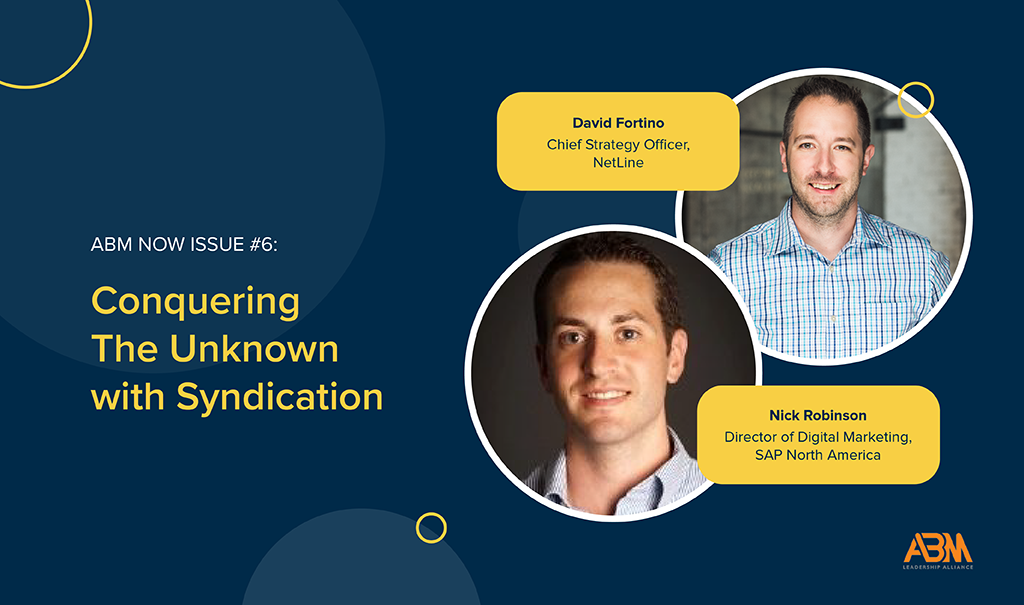This 7th Annual Benchmark Study, developed by ITSMA and the ABM Leadership Alliance, provides an essential review of the current state of play with Account-Based Marketing.
ebook

It’s a bit contrarian to say in the age of performance marketing, but sometimes you just don’t know. That is, sometimes you just don’t know who exactly is on the account’s buying team. Or, which of them are in your court. Or which ones hold sway.
In one famous study of organizational behavior, researchers redrew an org chart to reflect actual influence and it looked less like a lattice and more like a spiderweb. At the center of one company’s web sat an extraordinarily influential engineering manager with an innocuous title around which all decisions revolved.
To account for this uncertainty in your account-based marketing, you need to cast a wide content net and entertain doubts about what’s actually knowable. As my interviewees explained this week, it’s counterintuitive, but it’s the only way you’ll know.
I sat down with Nick Robinson, Director of Digital Marketing for SAP North America, and David Fortino, CSO of NetLine to understand the critical role content syndication has to play.
Nick Robinson
As the Director of Digital Marketing at SAP North America, I help our region reach the buyers we don’t currently have access to. A lot of the work that I do is reaching, engaging, and converting new audiences and I’m typically targeting accounts that are dormant, haven’t bought in a while, or completely new to SAP. We do a lot of that through media buying, but I’m also inherently involved in web strategy and marketing automation because of the feedback loops required.
In North America, our biggest source of revenue is from roughly 11,000 companies. That’s not a huge addressable market, so we need partners who are highly targeted and can match against specific account sets and specific buying groups within those accounts. We also need to cater different types of content and messaging to different audiences within those account sets. For all that, you need scale, and you need a network and partner like NetLine that can reach those audiences in the right way.
Syndication helps us reach the people within accounts we didn’t necessarily expect to be involved in a deal. Take one financial services company for example. In 2019 we noticed someone there downloaded one asset. Then, five people downloaded it. By December, 40 people had downloaded it. Lo and behold, on January 2, somebody opened a very large opportunity for that company for the solution featured in that content, and none of the people on the deal were the ones who downloaded the asset. Without content marketing and without syndication, I’m not sure how we would have gotten materials into all those people’s hands.

David Fortino
You’re totally right, Nick, and it’s a story we hear a lot. I’m the Chief Strategy Officer at NetLine, which of course partners with SAP, and is the largest content-centric lead gen platform on the web. By content-centric, I mean we reach people where they’re already researching and buying with high-quality content our customers create, and make matches. If B2B marketers think of NetLine as one thing, it’s a way to repurpose their existing content to drive pipeline.
We don’t have an editorial staff creating content. Instead, we partner with expert publishers, like The Wall Street Journal on down to specific publishers like ALM in the legal market and thousands of others. We dynamically display your content before discrete, measurable, B2B audiences across that platform.
What’s great for our clients like Nick at SAP is that it’s on a pay-per-lead model, plus they receive the contact or account-centric data. With a team as advanced as theirs, they know how to accept that data, nurture it, escalate it, de-escalate it, and so on. It gives them a view of what the people at their accounts are actually doing, not just what the contacts they’re aware of are doing.
Nick
Honestly, for me, the real value of content marketing is that data output David is talking about. Those behavioral signals that make your other marketing tactics better, which is an idea Robert Rose, head of The Content Advisory, has talked a lot about. Our syndication programs provide us an immense amount of information on our key accounts and we use that information to better segment and target our event invites, lists, and territories.
We’ve seen that five people will download an asset but they aren’t the person who’ll engage with sales. And that’s okay. The role of the tactic is educating that buying group, whoever they are, wherever they are. Not everyone who reads becomes a lead, but they can be a hidden influencer.
David
Yeah that’s huge, Nick. Your point about using content as a way to educate and build trust and credibility with future buyers is core to the whole idea. Without that mindset, you’ll be going after every single person who engages with your content and they don’t want to hear from sales. Something like 1% of buyers are ready to buy right now, yet most demand generation programs treat them all like they are, and it creates pressure and mistrust.
One of our initiatives in this new year is helping to educate marketers accustomed to direct lead-generation tactics that not everyone who engages should talk to sales. That interaction could be simply informational and the question is, what signals can you decipher from it? How do you help them self-educate if that’s what they want? Often the worst thing you can do is simply toss that lead over the fence and say, “Get this person on a call.”
Nick
My sense is that over the past decade, marketers have over-rotated on performance marketing and hardcore lead generation. We could all use better balance. I would encourage all marketers to think about their marketing plans in terms of reputation. From first interaction all the way down to pipeline acceleration, organize your programs for one outcome: buyer education.
David
Similarly, for me, it’s to stop chasing numbers for numbers’ sake. Clearly, every single decision we make is with data, but if you’re chasing topline numbers only and not seeing the intangible yet actionable business outcomes, you’re fooling yourself. Focus on the bottom of any of your progressions, whether it’s a linear funnel or a chaotic one. This is not to say to disregard impressions. Impressions are a signal. But do worry about them less.
Nick
That you can manage through any disruption if you have a solid understanding of how your marketing plan translates into revenue. All other fundamentals follow—the segments, the justification for why one of those segments will prove valuable over another, the messaging, the themes. Know how your marketing makes money.
David
I’ll take the product-led philosophy that we’ve leaned into this year. We’ve moved more into the SMB market, which is a completely different sale for us. We also challenged ourselves to externalize our “special sauce” by creating a free tool called Audience Explorer. The tool was built to remove the mystery around B2B content consumption patterns being generated by professionals as they actively research their various challenges and needs. Our theory is that by setting this data free, we’re powering our customer’s decisions with NetLine and beyond. We’re giving the internal goodness away for free and it’s some of the best education we can offer our buyers.
It’s all part of our becoming even more hyper-attuned to our audience’s needs, and the understanding that it’s about the quality of touches within a specific account.

Director of Demand Gen, Demandbase
Brandon possesses extensive experience helping organizations create and orchestrate strategic programs that help to retain customers and power sales execution. He’s passionate about the intersection between tech and psychology, especially as it applies to growing businesses. He enjoys reading, playing hockey, and most outdoor sports. Check him out on twitter @brandon_lee_09 or connect with him on LinkedIn at www.linkedin.com/in/brandonredlinger/.

Chief Strategy Officer, NetLine
Helping Today's B2B Marketer Solve Tomorrow's Marketing Challenges. David is responsible for the strategic direction and adoption of NetLine's A.M.P (Audience, Marketing, and Product) initiatives. He brings more than 15 years’ experience of developing and managing self-service B2B content distribution, audience monetization, and digital marketing platforms.

Director of Digital Marketing, SAP North America
Nick Robinson is the Digital Marketing Director at SAP North America and is responsible for all digital channel contribution to pipeline and revenue. From media buying, web strategy, and marketing automation to analytics and account segmentation, his focus ensures growth in strategic market segments.